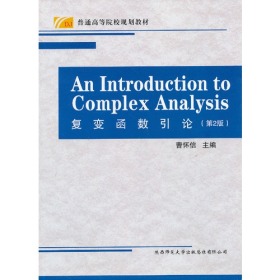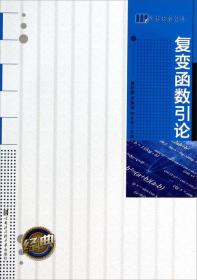
复变函数引论英文
实拍图,高温消毒后发出,下午四点之前的订单一般当天发货
¥ 2.42 九品
仅1件
天津宝坻
认证卖家担保交易快速发货售后保障
作者曹怀信 主编
出版社陕西师范大学出版社
出版时间2013-01
版次2
装帧平装
上书时间2024-11-06
- 在售商品 暂无
- 平均发货时间 10小时
- 好评率 暂无
- 最新上架
商品详情
- 品相描述:九品
图书标准信息
- 作者 曹怀信 主编
- 出版社 陕西师范大学出版社
- 出版时间 2013-01
- 版次 2
- ISBN 9787561369104
- 定价 35.00元
- 装帧 平装
- 开本 16开
- 纸张 胶版纸
- 页数 306页
- 【内容简介】
- 曹怀信编著的《复变函数引论(第2版)》简介:For several years, I have beenconducting courses in Complex Analysis, Real Analysis andFunctional Analysis in a so-called "bilingual" way. That is, thelessons are given with Chinese textbooks, but mainly teached inEnglish. The main purpose of teaching in this way is to improve theundergraduate students' ability to read and write English. Using aChinese textbook in such "bilingual" courses is not, however,useful for training students' ability of English-thinking.Consequently, although there are a number of books on complexanalysis in Chinese, in order to meet the requirements of bilingualteaching, it is necessary to write a textbook on complex analysisin English for Chinese undergraduate students. This is just themain aim of compiling the present book.
- 【目录】
- PrefaceChapter Ⅰ Complex Number Field 1.1 Sums and Products 1.2 Basic Algebraic Properties 1.3 Further Properties 1.4 Moduli 1.5 Conjugates 1.6 Exponential Form 1.7 Products and Quotients in Exponential Form 1.8 Roots of Complex Numbers 1.9 Examples 1.10 Regions in the Complex PlaneChapter Ⅱ Analytic Functions 2.1 Functions of a Complex Variable 2.2 Mappings 2.3 The Exponential Function and its Mapping Properties 2.4 Limits 2.5 Theorems on Limits 2.6 Limits Involving the Point at Infinity 2.7 Continuity 2.8 Derivatives 2.9 Differentiation Formulas 2.10 Cauchy-Riemann Equations 2.11 Necessary and Sufficient Conditions for Differentiability 2.12 Polar Coordinates 2.13 Analytic Functions 2.14 Examples 215 Harmonic FunctionsChapter Ⅲ Elementary Functions 3.1 The Exponential Function 3.2 The Logarithmic Function 3.3 Branches and Derivatives of Logarithms 3.4 Some Identities on Logarithms 3.5 Complex Power Functions 36 Trigonometric Functions 3.7 Hyperbolic Functions 3.8 Inverse Trigonometric and Hyperbolic FunctionsChapter Ⅳ Integrals 4.1 Derivatives of Complex-Valued Functions of One Real Variable 4.2 Definite Integrals of Functions W 4.3 Paths 4.4 Path Integrals 4.5 Examples 4.6 Upper Bounds for Integrals 4.7 Primitive Functions 4.8 Examples 4.9 Cauchy Integral Theorem 4.10 Proof of the Cauchy Integral Theorem 4.11 Extended Cauchy Integral Theorem 4.12 Cauchy Integral Formula 4.13 Derivatives of Analytic Functions 4.14 Liouville's Theorem 4.15 Maximum Modulus PrincipleChapter Ⅴ Series 5.1 Convergence of Series 5.2 Taylor Series 5.3 Examples 5.4 Laurent Series 5.5 Examples 5.6 Absolute and Uniform Convergence of Power Series 5.7 Continuity of Sums of Power Series 5.8 Integration and Differentiation of Power Series 5.9 Uniqueness of Series Representations 5.10 Multiplication and Division of Power SeriesChapter Ⅵ Residues and Poles 6.1 Residues 6.2 Cauchy's Residue Theorem 6.3 Using a Single Residue 6.4 The Three Types of Isolated Singular Points 6.5 Residues at poles 6.6 Examples 6.7 Zeros of Analytic Functions 6.8 Uniquely Determined Analytic Functions 6.9 Zeros and Poles 6.10 Behavior of f Near Isolated Singular Points 6.11 Reflection PrincipleChapter Ⅶ Applications of Residues 7 I Evaluation of Improper Integrals 7.2 Examples 7.3 Improper Integrals From Fourier Analysis 7.4 Jordan's Lemma 7.5 Indented Paths 7.6 An Indentation Around a Branch Point 7.7 Definite Integrals Involving Sine and Cosine 7.8 Argument Principle 7.9 Rouche's TheoremChapter Ⅷ Conformal Mappings 8.1 Conformal mappings 82 Unilateral Functions 8.3 Local Inverses 84 Affine Transformations 85 The Transformation W = 1/z 8.6 Mappings by 1/z 8.7 Fractional Linear Transformations 8.8 Cross Ratios 8.9 Mappings of the Upper Half Plane
点击展开
点击收起
相关推荐
— 没有更多了 —


















以下为对购买帮助不大的评价